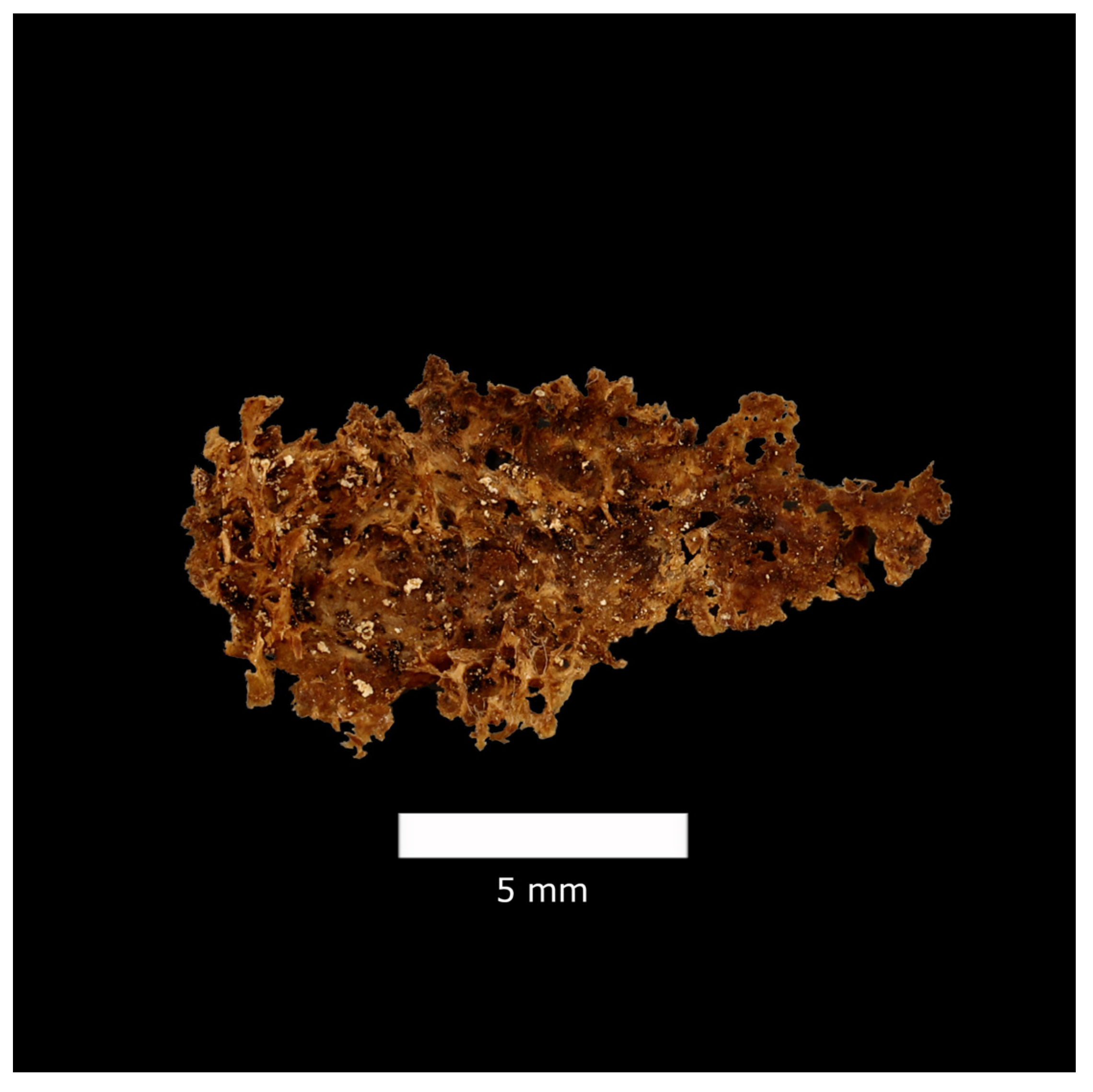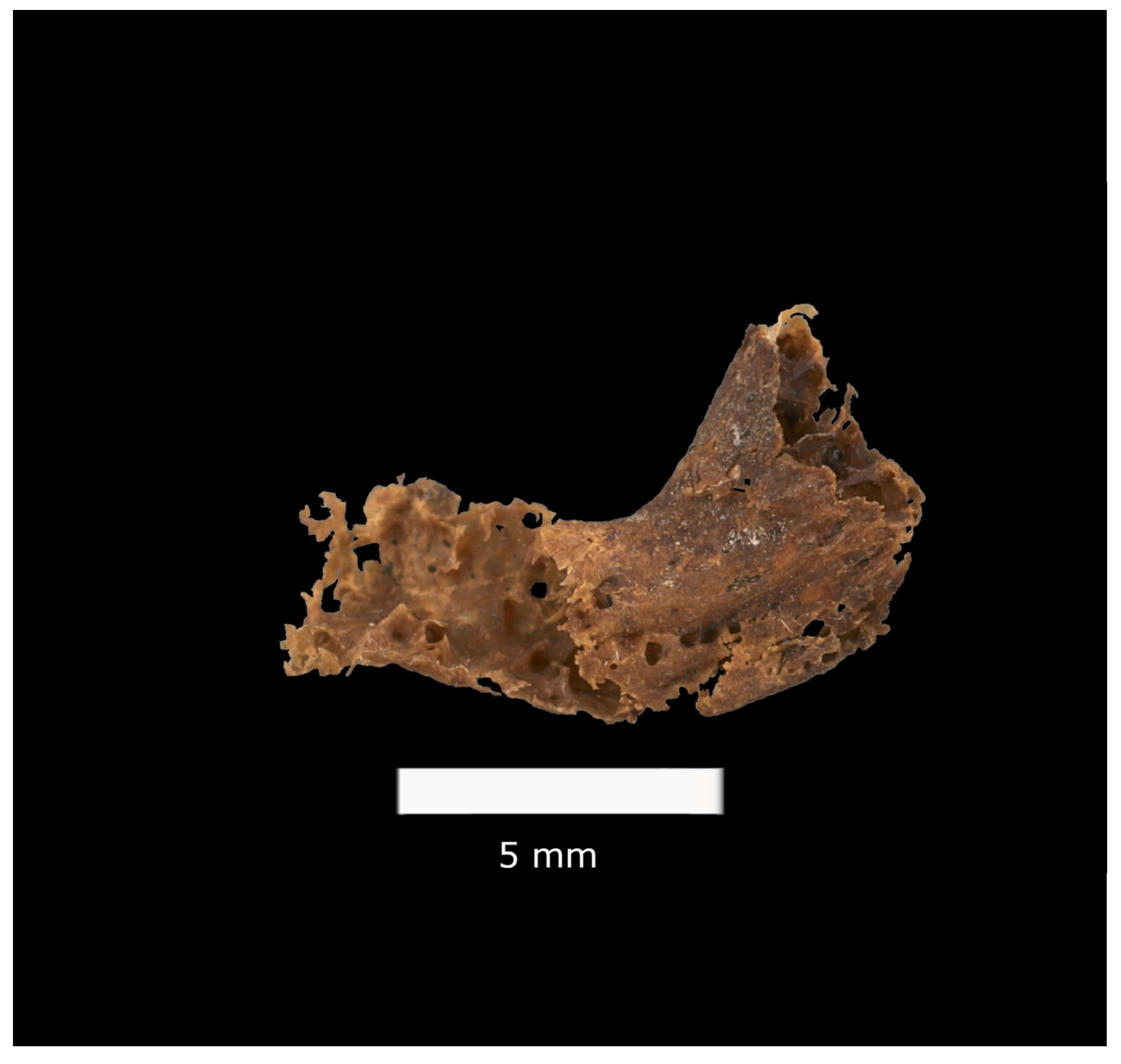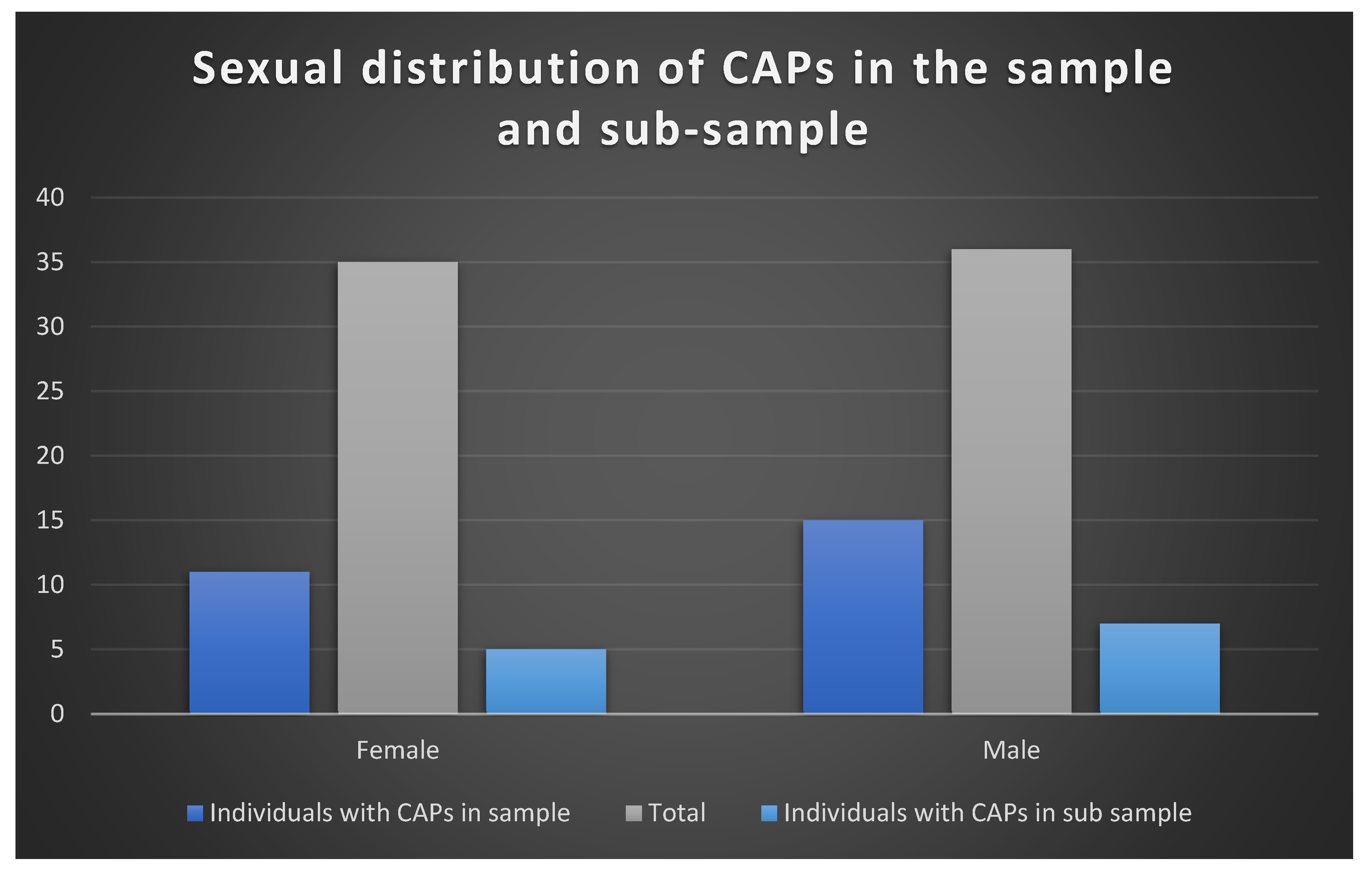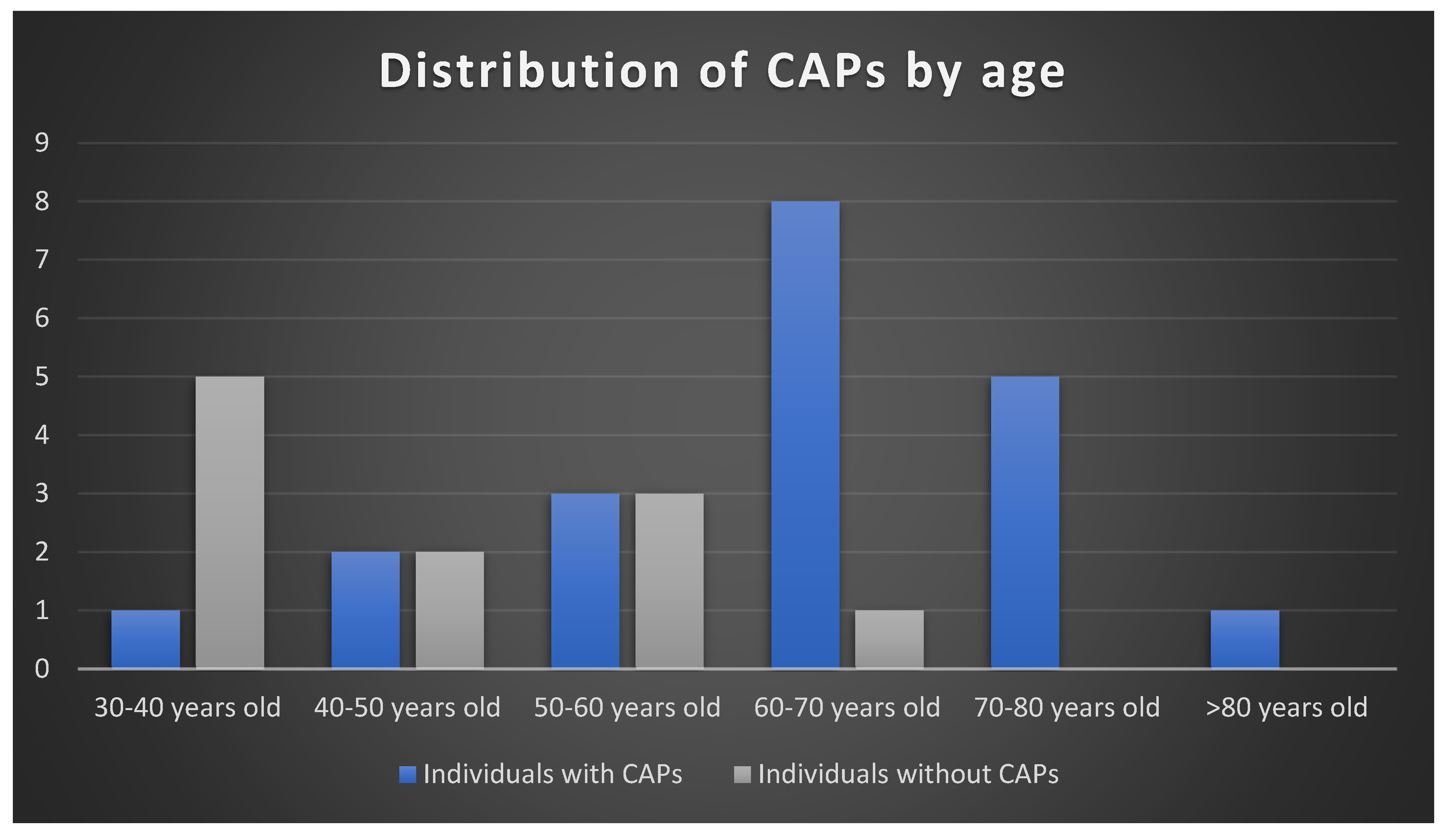The Identification Potential of Atherosclerotic Calcifications in the Context of Forensic Anthropology
Abstract
Simple Summary
Abstract
1. Introduction
2. Materials and Methods
2.1. This Study-Sample
2.2. Methodological Approaches
3. Results
4. Discussion
5. Conclusions
Author Contributions
Funding
Institutional Review Board Statement
Informed Consent Statement
Data Availability Statement
Acknowledgments
Conflicts of Interest
References
- Allison, M.A.; Criqui, M.H.; Wright, C.M. Patterns and Risk Factors for Systemic Calcified Atherosclerosis. Arterioscler. Thromb. Vasc. Biol. 2004, 24, 331–336. [Google Scholar] [CrossRef] [PubMed]
- Doherty, T.M.; Asotra, K.; Fitzpatrick, L.A.; Qiao, J.-H.; Wilkin, D.J.; Detrano, R.C.; Dunstan, C.R.; Shah, P.K.; Rajavashisth, T.B. Calcification in atherosclerosis: Bone biology and chronic inflammation at the arterial crossroads. Proc. Natl. Acad. Sci. USA 2003, 100, 11201–11206. [Google Scholar] [CrossRef] [PubMed]
- Cunha, E. Considerações Sobre a Antropologia Forense Na Atualidade. Rev. Bras. De Odontol. Leg. 2017, 4, 110–117. [Google Scholar] [CrossRef][Green Version]
- Agatston, A.S.; Janowitz, W.R.; Hildner, F.J.; Zusmer, N.R.; Viamonte, M.; Detrano, R. Quantification of coronary artery calcium using ultrafast computed tomography. J. Am. Coll. Cardiol. 1990, 15, 827–832. [Google Scholar] [CrossRef]
- Mori, S.; Takaya, T.; Kinugasa, M.; Ito, T.; Takamine, S.; Fujiwara, S.; Nishii, T.; Kono, A.K.; Inoue, T.; Satomi-Kobayashi, S.; et al. Three-dimensional quantification and visualization of aortic calcification by multidetector-row computed tomography: A simple approach using a volume-rendering method. Atherosclerosis 2015, 239, 622–628. [Google Scholar] [CrossRef]
- Biehler-Gomez, L.; Cappella, A.; Castoldi, E.; Martrille, L.; Cattaneo, C. Survival of Atherosclerotic Calcifications in Skeletonized Material: Forensic and Pathological Implications. J. Forensic Sci. 2018, 63, 386–394. [Google Scholar] [CrossRef] [PubMed]
- Ross, A.H.; Lanfear, A.K.; Maxwell, A.B. Establishing standards for side-by-side radiographic comparisons. Am. J. Forensic Med. Pathol. 2016, 37, 86–94. [Google Scholar] [CrossRef] [PubMed]
- Goodwin, W.H.; Simmons, T. Disaster Victim Identification. Encyclopedia of Forensic Sciences, 2nd ed.; Academic Press: London, UK, 2013; pp. 332–338. [Google Scholar] [CrossRef]
- Cardoso, H.F.V. Brief communication: The collection of identified human skeletons housed at the Bocage Museum (National Museum of Natural History), Lisbon, Portugal. Am. J. Phys. Anthropol. 2006, 129, 173–176. [Google Scholar] [CrossRef]
- Lusis, A.J. Atherosclerosis Aldons. Nature 2010, 407, 233–241. [Google Scholar] [CrossRef]
- Hakyemez, B.; Erdogan, C.; Oruc, E.; Aker, S.; Aksoy, K.; Parlak, M. Foramen of Monro meningioma with atypical appearance: CT and conventional MR findings. Australas. Radiol. 2007, 51 (Suppl. S1), 3–5. [Google Scholar] [CrossRef]
- Kawaguchi, T.; Fujimura, M.; Tominaga, T. Grossly calcified choroid plexus concealing foramen of Monro meningiomas as an unusual cause of obstructive hydrocephalus. Asian J. Neurosurg. 2016, 11, 96. [Google Scholar] [CrossRef] [PubMed]
- Demer, L.L.; Tintut, Y. Vascular calcification: Pathobiology of a multifaceted disease. Circulation 2008, 117, 2938–2948. [Google Scholar] [CrossRef] [PubMed]
- Olechnowicz-Tietz, S.; Gluba, A.; Paradowska, A.; Banach, M.; Rysz, J. The risk of atherosclerosis in patients with chronic kidney disease. Int. Urol. Nephrol. 2013, 45, 1605–1612. [Google Scholar] [CrossRef] [PubMed][Green Version]
- Kon, V.; Linton, M.F.; Fazio, S. Atherosclerosis in chronic kidney disease: The role of macrophages. Bone 2008, 23, 45–54. [Google Scholar] [CrossRef] [PubMed]
- Hamerman, D. Osteoporosis and atherosclerosis: Biological linkages and the emergence of dual-purpose therapies. QJM Int. J. Med. 2005, 98, 467–484. [Google Scholar] [CrossRef] [PubMed]
- Sprini, D.; Rini, G.B.; Di Stefano, L.; Cianferotti, L.; Napoli, N. Correlation between osteoporosis and cardiovascular disease. Clin. Cases Miner. Bone Metab. 2014, 11, 117–119. [Google Scholar] [CrossRef]
- Stojanovic, O.I.; Lazovic, M.; Lazovic, M.; Vuceljic, M. Association between atherosclerosis and osteoporosis, the role of vitamin D. Arch. Med. Sci. 2011, 7, 179–188. [Google Scholar] [CrossRef]
- Lopes, N.H.M. The interface between osteoporosis and atherosclerosis in postmenopausal women. Arq. Bras. Cardiol. 2018, 110, 217–218. [Google Scholar] [CrossRef]
- Curate, F. Osteoporosis and paleopathology: A review. J. Anthropol. Sci. 2014, 92, 119–146. [Google Scholar] [CrossRef]
- Biehler-Gomez, L.; Maderna, E.; Brescia, G.; Caruso, V.; Rizzi, A.; Cattaneo, C. Distinguishing Atherosclerotic Calcifications in Dry Bone: Implications for Forensic Identification. J. Forensic Sci. 2019, 64, 839–844. [Google Scholar] [CrossRef]
- Santos, A.L.; Matos, V.M.J. Contribution of paleopathology to the knowledge of the origin and spread of tuberculosis: Evidence from Portugal. Antropol. Port. 2019, 36, 47–65. [Google Scholar] [CrossRef] [PubMed]
- Kim, Y.S.; Lee, I.S.; Oh, C.S.; Kim, M.J.; Cha, S.C.; Shin, D.H. Calcified pulmonary nodules identified in a 350-year-old-joseon mummy: The first report on ancient pulmonary tuberculosis from archaeologically obtained pre-modern Korean samples. J. Korean Med. Sci. 2016, 31, 147–151. [Google Scholar] [CrossRef] [PubMed]
- Wasterlain, S.; Alves, R.; Garcia, S.; Marques, A. Ovarian teratoma: A case from 15th–18th century Lisbon, Portugal. Int. J. Paleopathol. 2017, 18, 38–43. [Google Scholar] [CrossRef]
- Fernandes, T.; Granja, R.; Thillaud, P.L. Spectrometric analysis and scanning electronic microscopy of two pleural plaques from mediaeval Portuguese period. Rev. Port. Pneumol. 2014, 20, 260–263. [Google Scholar] [CrossRef] [PubMed]
- Saade, C.; Najem, E.; Asmar, K.; Salman, R.; Achkar, B.E.l.; Naffaa, L. Intracranial calcifications on CT: An updated review. J. Radiol. Case Rep. 2020, 13, 1–18. [Google Scholar] [CrossRef]
- Akoglu, H. User’s guide to correlation coefficients. Turk. J. Emerg. Med. 2018, 18, 91–93. [Google Scholar] [CrossRef] [PubMed]
- Allen, M. Cramér’s V. The SAGE Encyclopedia of Communication Research Methods; SAGE Publications: Thousand Oaks, CA, USA, 2017; pp. 1–4. [Google Scholar] [CrossRef]
- Kim, H.-Y. Statistical notes for clinical researchers: Chi-squared test and Fisher’s exact test. Restor. Dent. Endod. 2017, 42, 152. [Google Scholar] [CrossRef]
- LeBlanc, V.; Cox, M.A.A. Interpretation of the Point-Biserial Correlation Coefficient in the Context of a School Examination. Quant. Methods Psychol. 2017, 13, 46–56. [Google Scholar] [CrossRef][Green Version]
- Mchugh, M.L. The Chi-square test of independence Lessons in biostatistics. Biochem. Medica 2013, 23, 143–149. [Google Scholar] [CrossRef]
- Pardo, L.; Martín, N. Minimum phi-divergence estimators and phi-divergence test statistics in contingency tables with symmetry structure: An overview. Symmetry 2010, 2, 1108–1120. [Google Scholar] [CrossRef]
- Rubinstein, R.Y.; Kroese, D.P. Simulation and the Monte Carlo Method, 3rd ed.; John Wiley & Sons: Hoboken, NJ, USA, 2016; pp. 1–414. [Google Scholar] [CrossRef]
- Cattaneo, C.; Mazzarelli, D.; Cappella, A.; Castoldi, E.; Mattia, M.; Poppa, P.; De Angelis, D.; Vitello, A.; Biehler-Gomez, L. A modern documented Italian identified skeletal collection of 2127 skeletons: The CAL Milano Cemetery Skeletal Collection. Forensic Sci. Int. 2018, 287, 219.e1–219.e5. [Google Scholar] [CrossRef] [PubMed]
- Biehler-Gomez, L.; Maderna, E.; Cattaneo, C. Calcified Residues of Soft Tissue Disease. In Interpreting Bone Lesions and Pathology for Forensic Practice; Biehler-Gomez, L., Cattaneo, C., Eds.; Academic Press: Cambridge, MA, USA, 2021; pp. 163–190. [Google Scholar] [CrossRef]
- Binder, M.; Roberts, C.A. Calcified structures associated with human skeletal remains: Possible atherosclerosis affecting the population buried at Amara West, Sudan (1300–800 BC). Int. J. Paleopathol. 2014, 6, 20–29. [Google Scholar] [CrossRef] [PubMed]




Disclaimer/Publisher’s Note: The statements, opinions and data contained in all publications are solely those of the individual author(s) and contributor(s) and not of MDPI and/or the editor(s). MDPI and/or the editor(s) disclaim responsibility for any injury to people or property resulting from any ideas, methods, instructions or products referred to in the content. |
© 2024 by the authors. Licensee MDPI, Basel, Switzerland. This article is an open access article distributed under the terms and conditions of the Creative Commons Attribution (CC BY) license (https://creativecommons.org/licenses/by/4.0/).
Share and Cite
Monteiro, S.; Curate, F.; Garcia, S.; Cunha, E. The Identification Potential of Atherosclerotic Calcifications in the Context of Forensic Anthropology. Biology 2024, 13, 66. https://doi.org/10.3390/biology13020066
Monteiro S, Curate F, Garcia S, Cunha E. The Identification Potential of Atherosclerotic Calcifications in the Context of Forensic Anthropology. Biology. 2024; 13(2):66. https://doi.org/10.3390/biology13020066
Chicago/Turabian StyleMonteiro, Sara, Francisco Curate, Susana Garcia, and Eugénia Cunha. 2024. "The Identification Potential of Atherosclerotic Calcifications in the Context of Forensic Anthropology" Biology 13, no. 2: 66. https://doi.org/10.3390/biology13020066
APA StyleMonteiro, S., Curate, F., Garcia, S., & Cunha, E. (2024). The Identification Potential of Atherosclerotic Calcifications in the Context of Forensic Anthropology. Biology, 13(2), 66. https://doi.org/10.3390/biology13020066






